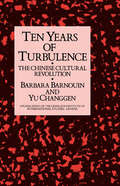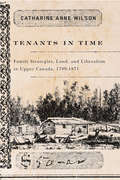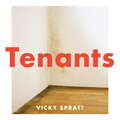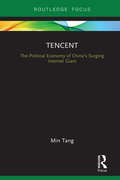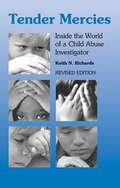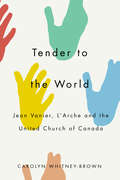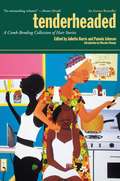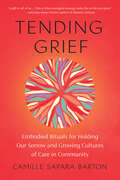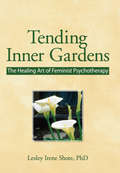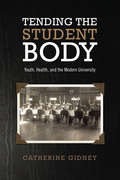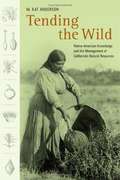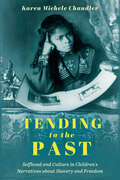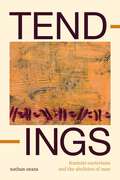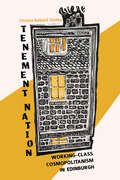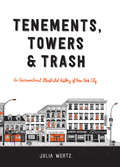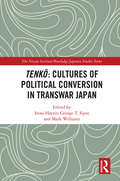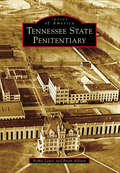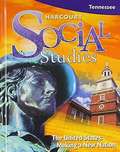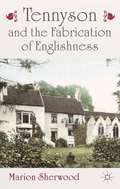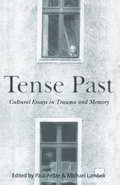- Table View
- List View
Ten Years Of Turbulence
by BarnouinFirst published in 1993. Routledge is an imprint of Taylor & Francis, an informa company.
Ten Years of Wanderings Among the Ethiopians: With Sketches of the Manners and Customs of the Civilised and Uncivilised Tribes from Senegal to Gaboon.
by Thomas J. HutchinsonAn account, first published in 1861, of the relationship between indigenous and European traders in the Niger Delta.
Tenants in Time
by Catharine Anne WilsonThe freeholding pioneer is a powerful image in settlement history - Tenants in Time tells a different story. Tenancy, though relegated to the periphery by the liberal idealization of ownership, was a common and vital part of the economy and society. Against a background of international land agitation and using an inter-disciplinary approach, Catharine Wilson looks at life as a tenant farmer, providing new insights into family strategies, land markets, and the growth of liberalism. Using evidence from across Upper Canada she shows how tenancy transformed the landscape and tied old and new settlers together in a continuum of mutual dependence that was essential to settlement, capital creation, and social mobility. Her analysis of customary rights reveals a landlord-tenant relationship - and a concept of ownership - more complex and flexible than previously understood. Landlords, from ordinary farmers to absentee aristocrats, are also part of the story and the much-criticized clergy reserves take a positive role. An intimate exploration of Cramahe Township follows tenants over the generations as they supported their families and combined liberal ideas with household-centered ways. From aggregate statistics to individual human dramas, Tenants in Time unravels the life of the tenant farmer in a wonderfully documented, engaging, and compelling argument.
Tenants in Time: Family Strategies, Land, and Liberalism in Upper Canada, 1799-1871
by Catharine Anne WilsonThe freeholding pioneer is a powerful image in settlement history - Tenants in Time tells a different story. Tenancy, though relegated to the periphery by the liberal idealization of ownership, was a common and vital part of the economy and society. Against a background of international land agitation and using an inter-disciplinary approach, Catharine Wilson looks at life as a tenant farmer, providing new insights into family strategies, land markets, and the growth of liberalism. Using evidence from across Upper Canada she shows how tenancy transformed the landscape and tied old and new settlers together in a continuum of mutual dependence that was essential to settlement, capital creation, and social mobility. Her analysis of customary rights reveals a landlord-tenant relationship - and a concept of ownership - more complex and flexible than previously understood. Landlords, from ordinary farmers to absentee aristocrats, are also part of the story and the much-criticized clergy reserves take a positive role. An intimate exploration of Cramahe Township follows tenants over the generations as they supported their families and combined liberal ideas with household-centered ways. From aggregate statistics to individual human dramas, Tenants in Time unravels the life of the tenant farmer in a wonderfully documented, engaging, and compelling argument.
Tenants: The People on the Frontline of Britain's Housing Emergency
by Vicky SprattONE OF THE BEST BOOKS OF 2022, METRO, EVENING STANDARD, REFINERY29, COSMOPOLITAN'A must-read' Cosmopolitan'A major new book on the history and politics of renting' Evening Standard'There is nobody better placed to write a book that tells the stories of "Britain's housing shame"' MetroTony is facing eviction instead of enjoying retirement; Limarra isn't 'homeless enough' to get help from the council; and for Kelly and her asthmatic son Morgan, another new rented house is a matter of life and death. This is twenty-first century Britain, where millions are forced into the private rental sector - a sector that creates profit for landlords, not safe and stable homes for tenants.In this fierce and moving account, journalist Vicky Spratt traces decades of bad policy decisions to show how and why the British dream of homeownership has withered and the safety net of social housing has broken. Through the lives of those in the renting trap, she illuminates the ways this crisis is devastating our health, communities and political landscape. But, as the Covid epidemic showed, there are also real, radical steps we can take to give everyone the chance of a good home.
Tencent: The Political Economy of China’s Surging Internet Giant (Global Media Giants)
by Min TangIn this book, author Min Tang examines the political economy of the China-based leading global Internet giant, Tencent. Tracing the historical context and shaping forces, the book illuminates Tencent’s emergence as a joint creation of the Chinese state and transnational financial capital. Tencent reveals interweaving axes of power on different levels, particularly interactions between the global digital industry and contemporary China. The expansion strategies Tencent has employed—horizontal and vertical integration, diversification and transnationalization—speak to the intrinsic trends of capitalist reproduction and the consistent features of the political economy of communications. The book also pinpoints two emerging and entangling trends— transnationalization and financialization—as unfolding trajectories of the global political economy. Understanding Tencent’s dynamics of growth helps to clarify the complex nature of China’s contemporary transformation and the multifaceted characteristics of its increasingly globalized Internet industry. This short and highly topical research volume is perfect for students and scholars of of global media, political economy, and Chinese business, media and communication, and society.
Tender Mercies: Inside the World of a Child Abuse Investigator
by Keith N. RichardsThis first-person, emotional account of a child protective services worker in New York State gives the reader an intimate look at all aspects of handling child abuse cases: interviewing parents, talking to abused children removed from their parents' care, and keeping up with the mounds of paperwork each case generates. Tender Mercies is a must-read for professionals and laypeople alike!
Tender to the World: Jean Vanier, L'Arche, and the United Church of Canada
by Carolyn Whitney-Brown"What is the secret that allows L'Arche to exist? I'll tell you: pleasure!" explains Jean Vanier, founder of the international federation of L'Arche communities where people with and without intellectual disabilities share their lives. Vanier's spiritual vision and playful sense of humour shaped L'Arche, but the organization was also informed by its surprising history with the United Church of Canada. In Tender to the World Carolyn Whitney-Brown explores the connections between the two organizations through diverse critical insights from Julia Kristeva, Doreen Massey, and Mikhail Bakhtin, as well as Vanier's controversial articulation of the gift of weakness. Tracing the five-decade relationship between L'Arche and the United Church alongside evolving disability theories, Whitney-Brown examines both the fundamental importance of stories and the agency of people with intellectual disabilities. Inversion - a transformative overturning of expectations in social interactions - can be upsetting or exciting, challenging or inspiring, she argues. This book offers a fresh look at how L'Arche and the United Church have worked to break down walls of difference, illuminating how each tenders something unexpected to the other and to the world. At a time when many are seeking new visions for society, the long and complex relationship between Canada's largest Protestant denomination and L'Arche offers both encouragement and a deeper way to approach questions of living in diverse communities.
Tenderheaded: A Comb-Bending Collection of Hair Stories
by Pamela Johnson Juliette HarrisWhat could make a smart woman ignore doctor's orders? What could get a hardworking employee fired from her job? What could get a black woman in hot water with her white boyfriend? In a word... HAIR. When does a few ounces feel like a few tons? When a doctor advises a black woman to start an exercise program and she wonders how she can do it without breaking a sweat. When an employer fires her for wearing a cultural hairstyle that's "unprofessional," and she has to go to court to plead for her job. When she's with her man, and the moment she's supposed to let loose, she stops to secure her head scarf so he doesn't disturb the 'do. TENDERHEADED? Yes, definitely. All black women are, in one way or another. The issue is not only about looking good, but about feeling adequate in a society where the beauty standards are unobtainable for most women. Tenderheaded boldly throws open the closet where black women's skeletons have been threatening to burst down the door. In poems, essays, cartoons, photos, and excerpts from novels and plays, women and men speak to the meaning hair has for them, and for society. In an intimate letter, A'Leila Perry Bundles pays tribute to her great-grandmother, hair-care pioneer Madam C.J. Walker, who launched a generation of African-American businesswomen. Corporate consultant Cherilyn "Liv" Wright interviews men and women on the hilarious ways they handle "the hair issue" between the sheets. Art historian Henry John Drewal explores how hairstyles, in Yoruba culture, indicate spiritual destiny, and activist Angela Davis questions how her message of revolution got reduced to a hairstyle. Tenderheaded is as rich and diverse as the children of the African diaspora. With works by Toni Morrison, Alice Walker, bell hooks, Henry Louis Gates Jr., and other writers of passion, persuasion, and humor -- this is sure to be one of the most talked-about books of the year.
Tending Grief: Embodied Rituals for Holding Our Sorrow and Growing Cultures of Care in Community
by Camille Sapara Barton&“Camille Sapara Barton is a gift to all of us. ... This is what emergent strategy looks like at the precipice.&” —adrienne maree brown, author of Pleasure ActivismAn embodied guide to being with grief individually and in community—practical exercises, decolonized rituals, and Earth-based medicines for healing and processing lossWe live in a culture that suppresses our ability to truly feel our grief—deeply, safely, and on our own terms. But each person&’s experience is as unique as the grief itself. Here, Camille Sapara Barton&’s take on grief speaks directly to the ways that BIPOC and queer readers disproportionately experience unique constellations of loss. Deeply practical and easy to use in times of confusion, trauma, and pain, Tending Grief includes rituals, reflection prompts, and exercises that help us process and metabolize our grief—without bypassing or pushing aside what comes to the fore. Sapara Barton includes exercises that can be done both alone and in community, including:Altar practices to honor and connect with ancestors known and unknownLocating, holding, and dancing your griefSharing circles for processing communal lossWater, fire, and nature-based ritualsHonoring the survival utility of numbness—and knowing when it&’s time to release itPeer support and integrationHerbal medicines and plant-based healingSapara Barton honors each and every experience: The loss of displacement from homelands, from severed lineages and ancestral ways of knowing. The grief of colonization and theft. The deep heaviness that burrows into our bodies when society tells us our bodies are wrong. Practical tools and rituals help readers feel into their grief, honor what comes up, and move forward in healing.Written specifically to center and hold the grief of BIPOC readers, Tending Grief is an invitation to reconnect to what we&’ve lost, to find community in our grief, and to tend to our own suffering for our individual and collective wellbeing.
Tending Inner Gardens: The Healing Art of Feminist Psychotherapy
by Lesley I ShoreTending Inner Gardens: The Healing Art of Feminist Psychotherapy transforms the theory and practice of psychotherapy, one that values both the feminine and masculine perspectives. Set within a naturalistic framework, this model utilizes nature’s growing and healing processes. It proposes nature’s seasonal cycles as a model for the psychotherapy process, and author Lesley Irene Shore introduces nature’s seasonal cycle as a model for successful psychotherapy and demonstrates how to tune techniques to the rhythms of each season.Dr. Shore speaks with the voice of an experienced psychotherapist, sharing her struggles with therapeutic dilemmas and addressing issues common to every practitioner. She refuses to present simple solutions to the difficult process of helping people grow, yet offers new ways of thinking about this work. Readers will find this a healing book--for themselves as well as for their clients.The book covers relationship issues as well as the use of language, hypnosis, dreams, and creativity. Specific areas readers learn about include: language--teaches therapists to differentiate between questions that address conscious regions of the mind and ones which communicate with less conscious processes. metaphor--describes ways of working with metaphors to access less conscious processes trauma--explores the effects of psychological trauma and offers tools for healing its wounds psychotherapy process--uses nature’s seasonal cycle to chart the process of psychotherapyTending Inner Gardens transcends the artificial dichotomies currently characterizing much psychological thought. Psychotherapists will be interested in the natural model of psychotherapy which integrates a wide range of ideas and theories, especially the sections on the psychotherapy relationship, dreams, creativity, working with metaphors, language, and the process of psychotherapy. Interesting case studies illuminate this material. Students can benefit from seeing how the tools of psychotherapy are integrated with the art. Laypeople will enjoy reading about Dr. Shore’s personal evolution as a therapist, her life on Harmony Farm, and her cases, which are discussed in detail.While this book is primarily geared toward a professional audience, it attracts a wide range of readers. It should be read by experienced psychotherapists, faculty members, and practitioners, as well as those in training. This would generally include psychiatrists, psychologists, social workers, counselors, psychiatric nurses, and related professions. And while the book presents a primarily verbal, psychodynamic approach toward healing, its theoretical conceptualization will appeal to professionals in healing traditions such as art therapy, massage therapy, and expressive therapy.
Tending the Student Body
by Catherine GidneyIn the early twentieth century, university administrators and educators regarded bodily health as a marker of an individual's moral and mental strength and as a measure of national vitality. Beset by social anxieties about the physical and moral health of their students, they introduced compulsory health services and physical education programs in order to shape their students' character. Tending the Student Body examines the development of these health programs at Canadian universities and the transformation of their goals over the first half of the twentieth century from fostering moral character to promoting individualism, self-realization, and mental health.Drawing on extensive records from Canadian universities, Catherine Gidney examines the gender and class dynamics of these programs, their relationship to changes in medical and intellectual thought, and their contribution to ideas about the nature and fulfilment of the self. Her research will be of interest to historians of medicine, gender, sport, and higher education.
Tending the Wild: Native American Knowledge and the Management of California's Natural Resources
by M. Kat AndersonAnderson's revolutionary thesis is that, far from being passive hunter and gatherers, Native Californians (and Native Americans generally) actively managed their natural environments in ways that today land managers could learn from.
Tending the Wild: Native American Knowledge and the Management of California's Natural Resources
by M. Kat AndersonJohn Muir was an early proponent of a view we still hold today--that much of California was pristine, untouched wilderness before the arrival of Europeans. But as this groundbreaking book demonstrates, what Muir was really seeing when he admired the grand vistas of Yosemite and the gold and purple flowers carpeting the Central Valley were the fertile gardens of the Sierra Miwok and Valley Yokuts Indians, modified and made productive by centuries of harvesting, tilling, sowing, pruning, and burning. Marvelously detailed and beautifully written, Tending the Wild is an unparalleled examination of Native American knowledge and uses of California's natural resources that reshapes our understanding of native cultures and shows how we might begin to use their knowledge in our own conservation efforts. M. Kat Anderson presents a wealth of information on native land management practices gleaned in part from interviews and correspondence with Native Americans who recall what their grandparents told them about how and when areas were burned, which plants were eaten and which were used for basketry, and how plants were tended. The complex picture that emerges from this and other historical source material dispels the hunter-gatherer stereotype long perpetuated in anthropological and historical literature. We come to see California's indigenous people as active agents of environmental change and stewardship. Tending the Wild persuasively argues that this traditional ecological knowledge is essential if we are to successfully meet the challenge of living sustainably.
Tending to the Past: Selfhood and Culture in Children's Narratives about Slavery and Freedom (Children's Literature Association Series)
by Karen Michele ChandlerIn many popular depictions of Black resistance to slavery, stereotypes around victimization and the heroic efforts of a small number of individuals abound. These ideas ignore the powers of ordinary families and obscure the systematic working of racism. Tending to the Past: Selfhood and Culture in Children’s Narratives about Slavery and Freedom examines Black-authored historical novels and films for children that counter this distortion and depict creative means by which ordinary African Americans survived slavery and racism in early America. Tending to the Past argues that this important, understudied historical writing—freedom narratives—calls on young readers to be active, critical thinkers about the past and its legacies within the present. The book examines how narratives by children’s book authors, such as Joyce Hansen, Julius Lester, Marilyn Nelson, and Patricia McKissack, and the filmmakers Charles Burnett and Zeinabu irene Davis, were influenced by Black cultural imperatives, such as the Black Arts Movement, to foster an engaged, culturally aware public. Through careful analysis of this rich body of work, Tending to the Past thus contributes to ongoing efforts to construct a history of Black children’s literature and film attuned to its range, specificity, and depths. Tending to the Past provides illuminating interpretations that will help scholars and educators see the significance of the freedom narratives’ reconstructions in a neoliberal era, a time of shrinking opportunities for many African Americans. It offers models for understanding the powers and continuing relevance of the Black child’s creative agency and the Black cultural practices that have fostered it.
Tendings: Feminist Esoterisms and the Abolition of Man
by Nathan SnazaIn Tendings, Nathan Snaza brings contemporary feminist and queer popular culture’s resurging interest in esoteric practices like tarot and witchcraft into conversation with Black feminist and new materialist thought. Analyzing writing and performances by Maryse Condé, Barbara Ehrenreich and Deirdre English, Starhawk, Christina Sharpe, Alexis Pauline Gumbs, and others, Snaza introduces his theory of tending as a concept that links ontology, attunement, care, and anticipatory action to explore how worlds persist through everyday acts of participation. In contrast to the universalizing presuppositions of the enlightenment, Snaza shows how certain feminist occult and esoteric practices constitute what he calls an endarkenment that embraces decolonial spiritual knowledge. Highlighting how endarkenment practices challenge universal presumptions and reject the racializing and colonialist mission of enlightenment modernity, Snaza demonstrates the ways esoterism affirms a pluriversal worldview that reimagines what it means to live in a more-than-human world.
Tenement Nation: Working-Class Cosmopolitanism in Edinburgh (Framing the Global)
by Christa Ballard TooleyAround the world, blue-collar politics have become associated with resistance to the multicultural. While this may also be true in Edinburgh, Scotland, a closer look reveals the growth of liberal democratic ideals in the working-class population, which has a much different goal: How can this European city keep the entrepreneurial forces of globalization from commodifying what is distinctly theirs?In Tenement Nation, Christa Ballard Tooley explores the battle for a neighborhood called the Canongate in Edinburgh's Old Town. Tooley's insightful study of the working-class Canongate community as they negotiate gentrification plans offers a complex view of class and nation. The threat of the Canongate's redevelopment motivated many throughout Edinburgh to lend their support to the residents' campaign. Against such development projects, alliances formed between upper-class heritage supporters and working-class urban residents, all of whom turned to institutions such as the European Union and UNESCO for support in restricting commercial development. Tenement Nation explores these negotiations between socioeconomic classes and even nationalities to show what Tooley calls a "working-class cosmopolitanism" in pursuit of social, economic, and political inclusion.
Tenements, Towers & Trash: An Unconventional Illustrated History of New York City
by Julia WertzA New York Times Notable Book of 2017! Here is New York, as you've never seen it before. A perfectly charming, sidesplittingly funny, intellectually entertaining illustrated history of the blocks, the buildings, and the guts of New York City, based on Julia Wertz's popular illustrated columns in The New Yorker and Harper's. In Tenements, Towers & Trash, Julia Wertz takes us behind the New York that you think you know. Not the tourist's New York-the Statue of Liberty makes a brief appearance and the Empire State Building not at all-but the guts, the underbelly, of this city that never sleeps. With drawings and comics in her signature style, Wertz regales us with streetscapes "Then and Now" and little-known tales, such as the lost history of Kim's Video, the complicated and unresolved business of Ray's Pizza, the vintage trash and horse bones that litter the shore of Brooklyn's Bottle Beach, the ludicrous pinball prohibition, Staten Island's secret abandoned boatyard, and the hair-raising legend of the infamous abortionist of Fifth Avenue, Madame Restell. From bars, bakeries, and bookstores to food carts, street cleaners, and apartments both cramped and grand, Tenements, Towers & Trash is a wild ride in a time machine taxi from the present day city to bygone days of yore.
Tenkō: Cultures Of Political Conversion In Transwar Japan (Nissan Institute/Routledge Japanese Studies)
by Irena Hayter; George T. Sipos; Mark WilliamsThis book approaches the concept of tenkō (political conversion) as a response to the global crisis of interwar modernity, as opposed to a distinctly Japanese experience in postwar debates. Tenkō connotes the expressions of ideological conversion performed by members of the Japanese Communist Party, starting in 1933, whereby they renounced Marxism and expressed support for Japan’s imperial expansion on the continent. Although tenkō has a significant presence in Japan’s postwar intellectual and literary histories, this contributed volume is one of the first in Englishm language scholarship to approach the phenomenon. International perspectives from both established and early career scholars show tenkō as inseparable from the global politics of empire, deeply marked by an age of mechanical reproduction, mediatization and the manipulation of language. Chapters draw on a wide range of interdisciplinary methodologies, from political theory and intellectual history to literary studies. In this way, tenkō is explored through new conceptual and analytical frameworks, including questions of gender and the role of affect in politics, implications that render the phenomenon distinctly relevant to the contemporary moment. Tenkō: Cultures of Political Conversion in Transwar Japan will prove a valuable resource to students and scholars of Japanese and East Asian history, literature and politics.
Tennessee State Penitentiary
by Yoshie Lewis Brian AllisonAs Tennessee grew into a modern state, it found itself increasingly beset by crime. In 1831, the legislature approved the construction of the first penitentiary. The pen world was violent and dark, with several major riots, fires, and escape attempts throughout the years. However, the prison also gave birth to a culture of creativity born from despair, with entertainment shows often featuring the biggest names in country music sharing the stage with inmate bands. The best-known pen, "the Castle," has become a familiar icon to filmgoers, being used in productions like The Last Castle and The Green Mile. Today, the building sits abandoned, facing an uncertain future.
Tennyson and the Fabrication of Englishness
by Marion SherwoodThrough an examination of Tennyson's 'domestic poetry' - his portrayals of England and the English - in their changing nineteenth-century context, this book demonstrates that many of his representations were 'fabrications', more idealized than real, which played a vital part in the country's developing identity and sense of its place in the world.
Tenochtitlan: Capital of the Aztec Empire (Ancient Cities of the New World)
by José Luis de RojasTenochtitlan, capital of the Aztec empire before the Spanish conquest, rivaled any other great city of its time. In Europe, only Paris, Venice, and Constantinople were larger. Cradled in the Valley of Mexico, the city is unique among New World capitals in that it was well-described and chronicled by the conquistadors who subsequently demolished it. This means that, though centuries of redevelopment have frustrated efforts to access the ancient city’s remains, much can be told about its urban landscape, politics, economy, and religion. <p><p> While Tenochtitlan commands a great deal of attention from archaeologists and Mesoamerican scholars, very little has been written about the city for a non-technical audience in English. In this fascinating book, eminent expert José Luis de Rojas presents an accessible yet authoritative exploration of this famous city--interweaving glimpses into its inhabitants’ daily lives with the broader stories of urbanization, culture, and the rise and fall of the Aztec empire.
Tense Past: Cultural Essays in Trauma and Memory
by Michael Lambek Paul AntzeTense Past provides a much needed appraisal and contextualization of the upsurge of interest in questions of memory and trauma evident in multiple personality and post-traumatic stress disorders, child abuse, and commemoration of the Holocaust. Contributors examine the historical origins of memory in psychiatric discourse and show its connection to broader developments in Western science and medicine. They address the new links between trauma and memory, and they explore how memory shapes the way traumatic events are put into narrative form. They also consider the social and political contexts in which sufferers speak and remember.
